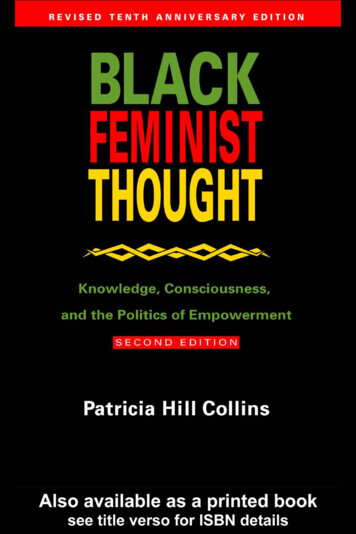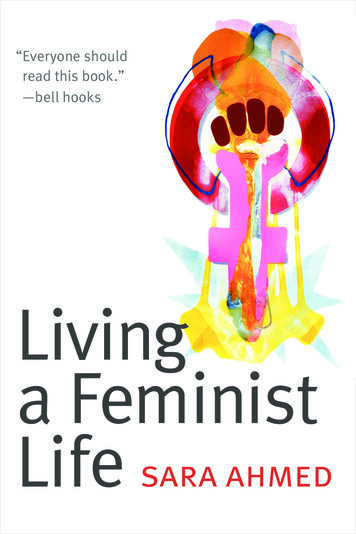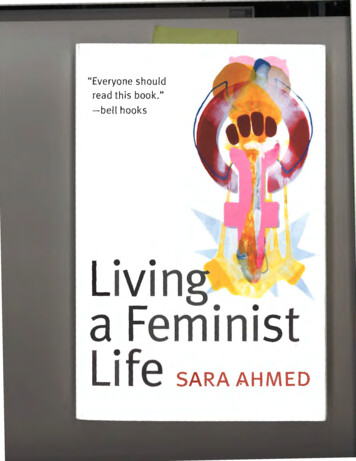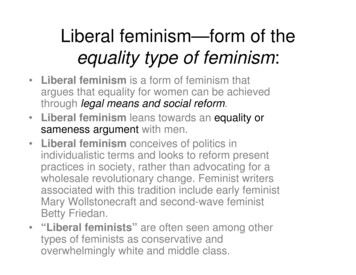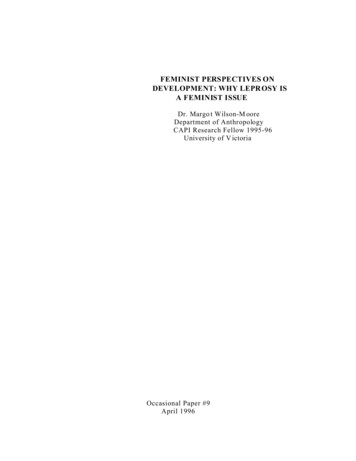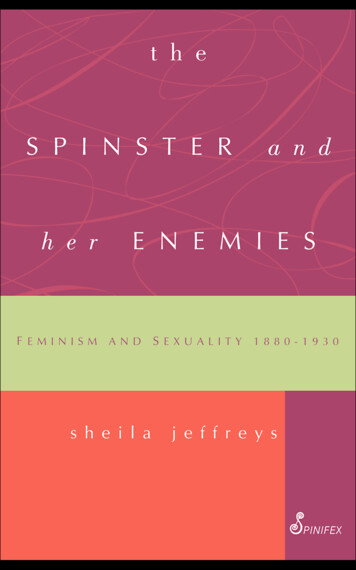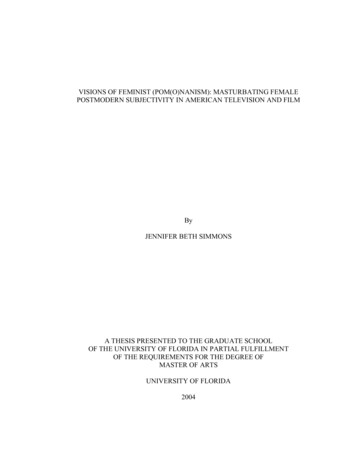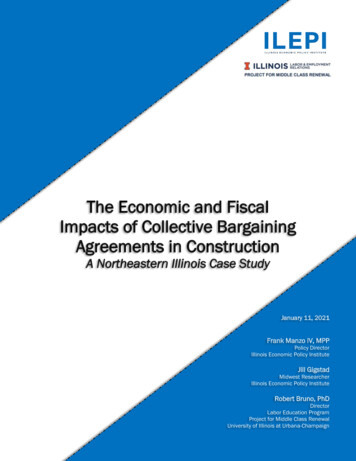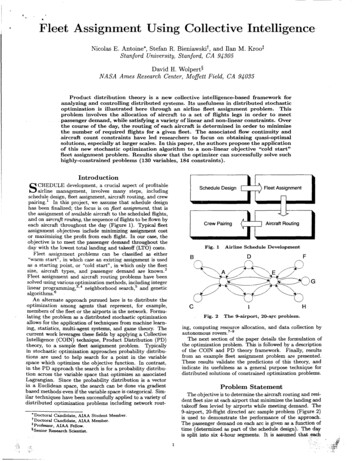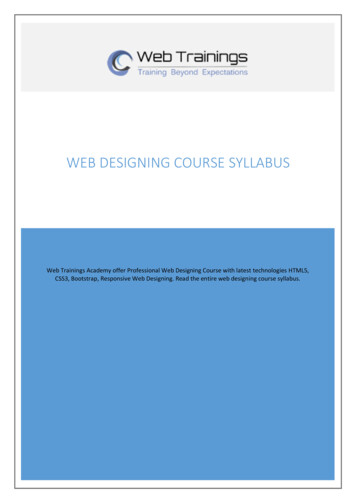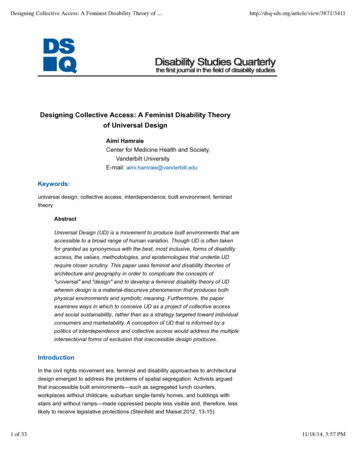
Transcription
Designing Collective Access: A Feminist Disability Theory of g Collective Access: A Feminist Disability Theoryof Universal DesignAimi HamraieCenter for Medicine Health and Society,Vanderbilt UniversityE-mail: aimi.hamraie@vanderbilt.eduKeywords:universal design; collective access; interdependence; built environment; feministtheoryAbstractUniversal Design (UD) is a movement to produce built environments that areaccessible to a broad range of human variation. Though UD is often takenfor granted as synonymous with the best, most inclusive, forms of disabilityaccess, the values, methodologies, and epistemologies that underlie UDrequire closer scrutiny. This paper uses feminist and disability theories ofarchitecture and geography in order to complicate the concepts of"universal" and "design" and to develop a feminist disability theory of UDwherein design is a material-discursive phenomenon that produces bothphysical environments and symbolic meaning. Furthermore, the paperexamines ways in which to conceive UD as a project of collective accessand social sustainability, rather than as a strategy targeted toward individualconsumers and marketability. A conception of UD that is informed by apolitics of interdependence and collective access would address the multipleintersectional forms of exclusion that inaccessible design produces.IntroductionIn the civil rights movement era, feminist and disability approaches to architecturaldesign emerged to address the problems of spatial segregation. Activists arguedthat inaccessible built environments—such as segregated lunch counters,workplaces without childcare, suburban single-family homes, and buildings withstairs and without ramps—made oppressed people less visible and, therefore, lesslikely to receive legislative protections (Steinfeld and Maisel 2012, 13-15).1 of 3311/18/14, 3:57 PM
Designing Collective Access: A Feminist Disability Theory of ut the 1960s and 70s, disability activists physically occupied publicbuildings in order to demonstrate that law and society had failed to include them(Nielsen 2012, 168). The efforts of these activists resulted in the passage of federalcivil rights legislation that aspired to protect the access of people with disabilities tothe built environment. The term barrier-free design emerged to describe thearchitectural strategies that underlie these legislative gains.Barrier-free design was not merely a legislative trope or expedient; rather, thetheory of barrier-free design supported efforts in the architectural profession todesign environments according to the spatial needs and demands of women,people of color, and people with disabilities (Matrix 1984; Steinfeld 1979; Mace1985; Weisman 1989; Welch and Jones 2002, 193). As architect Ray Lifchez wrote(1987, 1) in his groundbreaking Rethinking Architecture: Design Students andPhysically Disabled People:Building forms reflect how a society feels about itself and the world itinhabits. Valuable resources are given over to what is cherished—education, religion, commerce, family life, recreation—and tolerablesymbols mask what is intolerable—illness, deviance, poverty, disability,old age. Although architects do not create these social categories, theyplay a key role in providing the physical framework in which the sociallyacceptable is celebrated and the unacceptable is confined andcontained. Thus when any group that has been physically segregatedor excluded protests its second-class status, its members are in effectchallenging how architects practice their profession.A key contribution of late twentieth-century social movements to theories ofarchitectural design is crystallized in the connections that these movements drewbetween physical environments and the social realities that they create. Thesemovements and their professional counterparts showed that the design of buildingsis not a value-neutral and passive act; rather, the design of the built environmentactively conditions and shapes the assumptions that the designers, architects, andplanners of these value-laden contexts hold with respect to who will (and should)inhabit the world. In short, built environments serve as litmus tests of broader socialexclusions.Universal Design (UD) is an approach to access to the built environment that goesbeyond barrier-free design (Mace 1985). UD seeks to design built environments tobe as accessible as possible from the outset, to as many people as possible. Thatis, UD seeks to design built environments that will not require future retrofitting oralteration. Furthermore, UD goes beyond legal accessibility requirements (forexample, what is required to comply with the Americans with Disabilities Act) tointegrate into disability-access strategies the specific requirements that accruewhen designers take into account aging, gender, size, and health (among othervariables) (Steinfeld and Maisel 2012; Welch and Jones 2002). In the criticaldisability studies literature of the humanities and social sciences, UD has gainedtheoretical attention under the banner of "universal access." As feministgeographer Isabel Dyck notes, "conceptualizing the environment has been crucial2 of 3311/18/14, 3:57 PM
Designing Collective Access: A Feminist Disability Theory of .http://dsq-sds.org/article/view/3871/3411to the politics of disability research in delineating issues of access, a crucialdimension of a socio-spatial model of disability" (Dyck 2010, 254; emphasisadded). Feminist philosophy of disability and other disability theories cite UD toprove that disability is a product of the built and social environments, rather than amedical state that is intrinsic to the body of a given individual (Wendell 1996, 46;Silvers 1998, 74-75). In the terms of these philosophies and theories, the idea of auniversally-accessible environment is synonymous with the best, most inclusive,approach to design and defines the ideal outcome of disability politics. Disabledfeminist philosopher Susan Wendell inaugurates this position when she calls for a"universal recognition that all structures have to be built and all activities have to beorganized for the widest practical range of human abilities" (Wendell 1996, 55).Some feminist disability theorists have disagreed with Wendell, emphasizing thatthe physical environment alone is not enough to account for the exclusion ofpeople with sensory, cognitive, or mental disabilities from social and public life(Corker 2001, 39-40). Parallel debates over the desirability and scope of UD occurwithin the design professions. These professional debates hinge on the veryconcept of a universal, one-size-fits-all approach to design (Hannson 2007, 17;Sandhu 2011; Steinfeld and Tauke 2002). The implied tensions between thesedivergent approaches to access indicate that additional exploration of value-basedjustifications for UD is needed. In this paper, therefore, I parse out the potentialmeanings of the component terms of UD—namely, universal and design—ratherthan take for granted or dismiss what UD is or to what it aspires. In order to engagein this inquiry, I perform what feminist theorist Karen Barad calls a "diffractivereading," which she describes as a method of "reading insights through oneanother in ways that help illuminate differences as they emerge." Such a readingilluminates "how different differences get made, what gets excluded, and how thoseexclusions matter" (Barad 2007, 30). This approach to UD responds to RosemarieGarland-Thomson's call for feminist and disability studies to recognize their paralleldevelopment of theories in areas of overlapping interest (Garland-Thomson [2002]2011a, 1). In addition, the approach responds to recent scholarly appeals fordiscussions of the "philosophical and theoretical basis" of UD (Imrie 2012, 876).Rather than limit my discussion to the ideological basis of UD, I explore howshifting its frame and emphasis can better address issues with respect to the body,environment, and interdependence that both feminist philosophy of disability anddisability studies have articulated. In other words, I develop an idea of accessibledesign that construes it as a method of social justice activism, rather than as amarketing strategy. To do this, I draw upon four literatures, all of which address UDand have thus far had limited impact on UD thought: feminist philosophy ofdisability, feminist disability studies, feminist architectural theory, and disabilitygeographies of access. By bringing these literatures together, I hope to introducethem to a design audience, as well as to create space for discussions about designwithin feminist philosophy of disability/feminist disability studies. I shall first explainwhat UD is, exploring its design methodology and addressing some of theproblems that it raises. Then, I outline some of the issues and approaches that atheory of accessible design that is premised on interdependence can adopt tocreate broad and collective access to the built environment.3 of 3311/18/14, 3:57 PM
Designing Collective Access: A Feminist Disability Theory of ing Universal DesignThe architect Ronald Mace coined the term universal design in order to describeaccessibility that goes beyond the scope of barrier-free design (Mace 1985). Mace,a designer who used a wheelchair, defined UD like this:[UD is] a way of designing a building or facility, at little or no extra cost,so it is both attractive and functional for all people, disabled or not. Theidea is to remove that expensive, "special" label from products anddesigns for people with mobility problems, and at the same time,eliminate the institutional appearance of many current accessibledesigns. (Mace 1985, 1)Mace's goal of making the environment "functional for all people" echoed activistdemands for the integration of disability into broader conceptions of humancommunity and citizenship. Mace's initial definition of UD reflected a desire tomake the aesthetics and function of access more available and to focus less ondisabilities as an additional, extra, and unusual consideration—that is, as a "specialneed." Because Mace's definition of UD did not specify methods with which toachieve these aims and goals, he and other experts recognized the need to furtherspecify and elaborate what exactly universal design means and how it differs fromlegally-mandated accessibility under the Americans with Disabilities Act (ADA). 1 Inthe mid-1990s, therefore, Mace convened access experts at North Carolina StateUniversity's Center for Universal Design to craft a new definition. These expertsdefined UD as "the design of products and environments to be usable by allpeople, to the greatest extent possible, without the need for adaption or specializeddesign" (Center for Universal Design 1997). This definition retained Mace's initialnotion of a broad user group ("everyone" or "all") and added to it the idea thatbuildings and products must already account for the diversity within this group inthe way that these buildings and products are designed. The authors of this newdefinition also wrote the "Seven Principles of Universal Design," a document thatcontinues to be cited as the basis of UD (ibid.). The Seven Principles thataccompanied the new definition were: (1) Equitable use; (2) Flexibility in use; (3)Simple and intuitive; (4) Perceptible information; (5) Tolerance for error; (6) Lowphysical effort; and (7) Size and space for approach and use. Notwithstanding theappeal to equity in the first two principles, these guidelines do not appear to makean overarching ideological or value-based claim. Nor do any of the Principlesmention disability, leaving unanswered the question of whom equity and flexibilityare meant to benefit.In addition to the architectural strategies that have been developed to expand thework of barrier-free design and improve rehabilitation (Steinfeld, Paquet, d'Souza,Joesph, and Maisel 2010; Sanford 2012), several approaches to UD have emergedthat address the scope of inclusion and the strategies that can achieve it. Socialjustice approaches to UD build on disability, feminist, and environmental justicemovement work in order to educate architects and designers about human diversity(Ostroff 2001; Steinfeld and Tauke 2002; Weisman 1999). Industrial design4 of 3311/18/14, 3:57 PM
Designing Collective Access: A Feminist Disability Theory of r-oriented) approaches take UD beyond architecture to the design ofconsumer products and fixtures (Mueller 1997). Each approach brings a differentvalue, object, or methodology to UD. In this paper, I want to build upon socialjustice approaches to accessibility in order to articulate a theory that addressessome of the tensions and problems with consumer-oriented approaches to UD. Inorder to develop such a theory, I must first identify the key ideas that underlie thedefinitions and principles of UD. From these foundations of UD practice, three mainideas emerge:1. Accessibility by design (design that prioritizes accessibility)2. Broad accessibility (accessibility for the greatest number of peoplepossible)3. Added value (design that benefits disabled people also hasbenefits for nondisabled people)In what follows, I show that this formulation parses out the novel methodology of"Universal Designing" (Steinfeld and Tauke 2002) from its commitments toparticular framings of the "universal." Furthermore, this formulation allows me toanalyze the underlying theoretical, ideological, and value-based commitments thathave produced the orthodoxy according to which UD is synonymous with inclusiveor "good design" (Mace 1985, 152; Welch 1995; Tauke 2010; Goldsmith 2001a,1). 2Part I: Why design matters"Accessibility by design" is the methodology used to design a building or productthat prioritizes access, in addition to style and aesthetics. Accessibility by designcontrasts with the notion of "retrofit," which can be defined as the alteration ofexisting designs to fit the new requirements of spatial inhabitants (Center forUniversal Design 1997). For instance, a multi-level university building without anelevator or ramps will require a retrofit in order that some of its students, faculty,university staff, and members of the general public with disabilities can use all ofthe space. By contrast, a building equipped by design (i.e., from the outset) withramps and elevators is already usable to people with a range of mobility needs.Accessibility by design, in others words, is a "bottom-up methodology" thatpre-empts the need for legal accessibility requirements through the intentionalefforts of designers (Goldsmith 2001b, 25.1).As Lifchez argues, built environments are not merely the composite of physicalstructures; rather, they are also what Barad (2007) calls "material-discursive"phenomena. Barad uses the term material-discursive to refer to practices that bothproduce physical phenomena (such as buildings) and communicate meaning aboutwhat kinds of material and social relations should be possible (148). 3 In thecontext of architecture, for example, inaccessible and segregated environmentsendorse the participation of and distribution of resources to certain types of bodiesin public space, while marginalizing other types of bodies from which access andresources are withheld. The related concept of parti in architectural theory denotes5 of 3311/18/14, 3:57 PM
Designing Collective Access: A Feminist Disability Theory of .http://dsq-sds.org/article/view/3871/3411the way that buildings make arguments and convey meaning (Schumacher 2012,52). Parti is the "grammar" of architecture, or the material-discursive expression oflayout, style, and theme as evident in the design of a building. The concepts ofmaterial-discursive and parti show that buildings are not simply static structures inwhich human interaction occurs; on the contrary, buildings actually produce livedand embodied experiences for spatial inhabitants and, at times, form physicalboundaries that produce and reinforce structural inequalities.Access is defined in terms of the expression of inclusion in design, in addition to itsdefinition in terms of technical requirements. Although the parti of inaccessibleenvironments can be intentional, such environments often have an additionalunintentional parti that communicates the exclusion of minority embodiments. Forinstance, when a courthouse is designed with steps that lead to its entrance, thedesign of the building may make a statement about the transcendence of lawabove the people. Interior grand staircases that lead the public into courtrooms andjudges' chambers can communicate the democratic openness of arenas of legaldecision-making. Nevertheless, the very presence of stairs argues for a particularunderstanding of citizenship—one defined by the ability to climb steps—that resultsin an implicit and potent exclusion of people with mobility or sensory disabilitiesfrom the symbolic and physical aspects of courtroom space. Although the buildingmay communicate democratic intentions in some ways, its parti can, in other ways,produce material and symbolic exclusions of bodies for whom the design of thebuilding does not account.Protests against parti have been a key part of disability rights activism. Whendisabled protesters left their wheelchairs to climb or crawl up the steps ofcourthouses or federal buildings in the famous Section 504 protests, 4 theyperformed material-symbolic gestures that used their bodies in space asarguments against the parti of these buildings (Fleisher and Zames 2011, 53-55).The misfit between bodies and steps symbolized the segregation of disability frompublic life and the need for disability civil rights. This material, spatial, and symbolicactivism communicated meaning in a way that no courtroom proceedings,congressional testimony, and other discursive modes alone could do. In addition,this activism demanded that attention be paid to the underlying values andideologies in circulation that support designs that exclude disabled people frompublic space. As I argue in the next section, such underlying values areepistemological and methodological, as well as political.Theorizing Value-explicit DesignLike the civil rights-based design practices that have preceded it, UD is avalue-explicit design theory (D'Souza 2004, 3; Moore, Tuttle, and Howell1985). Value-explicit design theories render overt and apparent the values,ideologies, and partis of physical structures, assuming that design is neverideologically neutral. Whether explicitly or implicitly, built environments alwaysreference and imagine bodies and spatial inhabitants. Throughout its history,architecture, like scientific epistemologies, has either claimed ignorance of thebody or adopted a universal template of the ideal, geometric, and proportional6 of 3311/18/14, 3:57 PM
Designing Collective Access: A Feminist Disability Theory of .http://dsq-sds.org/article/view/3871/3411body (Hosey 2006; Imrie 2002). Nevertheless, both the presumed body andthe marginalized body are always implied in, structurally incorporated into, oractively excluded from, physical environments. As feminist philosopherElizabeth Grosz (2001) writes,Bodies are there in a way that architects don't want or can't affordto recognize. But the body is there in an incontrovertible way. Thepoint is to affirm that it's there, and to find the right kind of termsand values by which to make it profitable for architecture to think itsown investments in corporeality. (12-14)Value-explicit design exposes the reliance of design on a presumed cohort oftypical bodies. In keeping with Barad's notion of the material-discursive, that is,value-explicit design demonstrates that bodies and environments "areconjoined in their (mutual) production, meaning, and transformation" (Imrie2002, 64). Design methodologies that address specific values—such asdisability access, eco-sustainability, economic affordability, or gender equality—highlight the interactions between assumed bodies and design outcomes.Value-explicit design is an epistemic practice that relies upon, produces, andutilizes situated knowledge. Like feminist standpoint theories, the crux ofvalue-explicit design is that there is no neutral position or "view from nowhere"untouched by materiality, context, and identity (Haraway 1991). Althoughfeminist standpoint epistemology focuses on the social location of knowers,the role of architectural space as a location for experience is largely undertheorized in this literature. Moreover, although some feminist and disabilitytheories focus on the perspective of bodies that experience environmentalexclusion (Code 2006, xiv; Garland-Thomson [2002] 2011a; Mairs 1996), thestatus of designers as knowers who produce environmental contexts is rarelyexamined in the literature on UD, with the exception of critiques of designerlyauthority (Imrie 2012, 878). Value-explicit design does not privilege expertknowledge, but rather provides a framework within which designers can beheld accountable for the types of environments that they produce. UD is anapproach to value-explicit design that critiques the false value-neutrality ofinaccessible environments. Environments that are not universally usable arenot value-neutral; on the contrary, they are value-implicit. For example,buildings with over-stimulating lights or confusing layouts rarely, if ever, identifythemselves as positioned against people with sensory aversions or cognitivedisabilities; however, they become so through their design features. Valueexplicit designs, like wheelchair-accessible restrooms with transgenderinclusive signs, houses built at the scale of people of short stature, andkitchens with countertops that adjust to different heights, have the capacityand flexibility to meet the spatial requirements of specific types of embodimentin ways that also acknowledge a range of embodiments.Feminist and disability theories of access argue that supposedly value-neutralbuilt environments are material-discursive phenomena that mask thedominance of perceived majority identities and bodies. Leslie Kanes Weisman,7 of 3311/18/14, 3:57 PM
Designing Collective Access: A Feminist Disability Theory of .http://dsq-sds.org/article/view/3871/3411a feminist architectural theorist and UD educator, exemplifies this position inher "Women's Environmental Rights: A Manifesto," declaring:The built environment is largely the creation of white, masculinesubjectivity. It is neither value-free nor inclusively human. Feminismimplies that we fully recognize this environmental inadequacy andproceed to think and act out of that recognition. These arefeminist concerns which have critical dimensions that are bothsocietal and spatial. They will require feminist activism as well asarchitectural expertise to insure a solution. (Weisman [1981] 2000,5, emphasis added)In other words, the epistemic positions of designers matter for the materialdiscursive qualities of value-explicit design. Supposedly neutral design oftenprivileges the most common bodies through (what I have called) the "normatetemplate" for architectural design (Hamraie 2012). Garland-Thomson's termnormate represents the unmarked privilege of majority embodiments—white,male, cisgender, heterosexual, able-bodied, and middle-class bodies—thatappear neutral when their social location is in fact highly specific (GarlandThomson 1996, 8-10). When the normate serves as a neutral template fordesign, what emerges is a built environment that is accessible only to certainbodies. The normate template produces the illusion of what disabilitygeographer Rob Imrie characterizes as disembodied environments that "denythe presence or possibility of bodily impairment" (Imrie 2010, 40). Sincemarginalized and minority bodies must necessarily use space, they oftenexperience what Garland-Thomson calls "misfit." She writes:Like the dominant subject positions such as male, white, orheterosexual, fitting is a comfortable and unremarkable majorityexperience of material anonymity, an unmarked subject positionthat most of us occupy at some points in life and that often goesunnoticed. When we fit harmoniously and properly into the world,we forget the truth of contingency because the world sustains us.When we experience misfitting and recognize that disjuncture forits political potential, we expose the relational component and thefragility of fitting. Any of us can fit here today and misfit theretomorrow. (2011b, 11)Fitting and misfitting are material-discursive, relational, and interdependentcategories. In order to sustain itself, the normate template relies upon theimpression that normates are normal, average, and majority bodies. Misfittingshatters this illusion, marking the failure of the normate template toaccommodate human diversity. As disability sociologist Tanya Titchkoskyexplains, epistemic claims about disability as unknowable and thereforeexcludable sustain misfitting. Titchkosky puts it this way:The apparent and obvious ease of a statement like "things justweren't built with people with disabilities in mind" is a way to make8 of 3311/18/14, 3:57 PM
Designing Collective Access: A Feminist Disability Theory of ibility sensible under contemporary conditions. Thisordinary "truth claim" is a type of say-able thing in relation todisability. The say-able is where cultural understandings reside.(Titchkosky 2011, 74)In addition to revealing the cultural devaluation of misfit, keeping bodies andpeople "in mind" is an epistemic and material-discursive position (Imrie 2002,55). Designers produce misfit when they make claims such as: "You can'taccommodate everybody. You've got to draw the line somewhere" (Titchkosky2011, 31). As Barad explains in her theory of "agential cuts" (Barad 2007,176), acts of line-drawing are material-discursive practices that actually shapewhat kinds of bodies appear to be possible and likely to live in the world.Following Lifchez, inaccessible environments make the argument that disabledbodies are unworthy of inclusion and quite possibly do not even exist aspotential spatial inhabitants. The delineation of normate bodies as likely spatialinhabitants and misfits as "justifiably excludable" is not merely an act ofomission, but rather, is also a material-discursive act that solidifies normateprivilege (Titchkosky 2011, 78).Garland-Thomson's notion that environmental fit makes nondisabled peopleless aware of their own embodied privilege ("we forget the truth of contingencybecause the world sustains them") echoes moral philosopher Charles Mills's(1997, 97) argument that racism makes white people less likely toacknowledge and understand structural racism. Insofar as normate architectsand lawmakers claim that there are too many disabilities to "keep in mind," orthat they do not have the requisite information to design for minorityembodiments, they do not merely lack available information. On the contrary,these declarations reflect what critical race and feminist epistemologists call"epistemologies of ignorance" (Mills 1997; Tuana and Sullivan 2007).According to these theorists,ignorance is not the result of a benign gap in our knowledge, butdeliberate choices to pursue certain kinds of knowledge whileignoring others. We must therefore concern ourselves with ourchoices of knowledge production and who we take ourselves to beaccountable to through these choices. (Grasswick 2011, xvii)In other words, epistemologies of ignorance show that misfit is an activeconstruction of what appears to be a lack of information about the range ofhuman diversity. Knowledge and ideologies privileging the normate are alwayspresent in built environments. The point, following Garland-Thomson, Grosz,and Lifchez, is to affirm the normate template as a produced parti ofignorance, rather than simply an effect of designerly business as usual.Privileging the embodied user experience of misfit through accessibility canalso assist in the conceptualization of alternatives to epistemologies ofignorance. Value-explicit design can challenge the epistemic subject-objectrelationship between designers and spatial inhabitants. For instance,9 of 3311/18/14, 3:57 PM
Designing Collective Access: A Feminist Disability Theory of atory design methodologies that feminist and disability-focuseddesigners have developed offer a way in which to use designerly knowledge tocritique the normate template's epistemology of ignorance. Lifchez famouslyinvited people with disabilities into the design studio at the University ofCalifornia-Berkeley School of Architecture in order to train students inaccessible-design strategies (Lifchez 1987). In doing so, he centered disabilityand made design students accountable to the needs of disabled users. Healso decentered the designer as the authoritative knower or expert, trainingstudents to take on partnership roles with their intended clients and to valuetheir authority and expertise about their experiences of the built environment.The translation of experience into design is hardly straightforward; it is notsurprising, therefore, that participants in the process noted the difficulties thatstudents had with shifting expertise to clients with disabilities (Sarkissian 1987,142). Nevertheless, Lifchez's methods privileged users, brought them intomuch closer proximity with designers, and made disability intelligible to designstudents. Other architectural educators, like Weisman, have educated newgenerations of design students in UD methodologies and research throughwork like the Universal Design Education Project (Welch 1995) anduser-centered community partnerships (Weisman 2012). This work providesalternatives to value-neu
to the politics of disability research in delineating issues of access, a crucial dimension of a socio-spatial model of disability" (Dyck 2010, 254; emphasis added). Feminist philosophy of disability and other disability theories cite UD to prove that disability is a product of the built and social environments, rather than a
